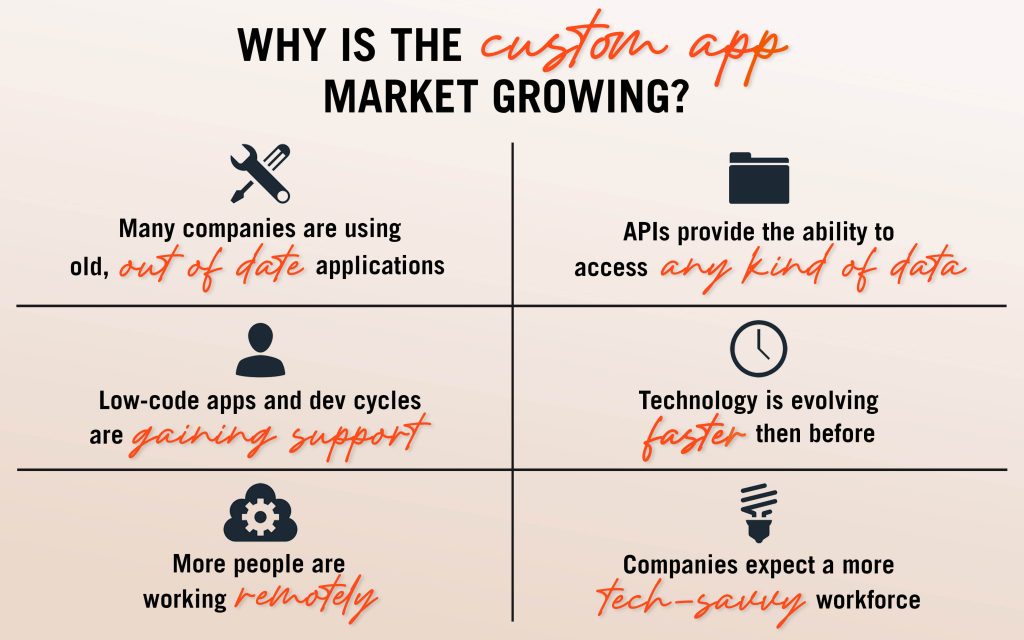
I work for a custom software developer. As such, my biggest competitors are not other custom developers or even new technologies. My biggest competitor is apathy, where the customer does not make any decision, or they choose an off-the-shelf application (also known as commercial-off-the-shelf applications, or COTS). COTS applications are prebuilt for a specific niche market.

Almost every industry has specific off-the-shelf solutions, from healthcare to law to advertising, etc. There are thousands of pre-made applications that companies can purchase, download, and deploy. If there are so many options, then why do custom software developers exist and thrive currently?
Before I speculate, let’s talk about the 80% rule. Whenever I meet a new prospect in an industry that has available off-the-shelf solutions, I will ask a simple series of questions:
- Are you currently using an application? What does it not do for you? What does it do well?
- Have you looked for a premade solution in your industry? What do you like about it?
- Does a premade (or your current) solution cover 80% or more of your workflow? If the answer is yes, then a custom solution is most likely not for you. The missing <20% could possibly be bridged by API connectivity or simply accepting a gap in the workflow.

Building a custom solution will cost more money than a prebuilt solution and will require sweat equity from yourself and your team. Expect discovery and design phases, scope changes, defining a minimum viable product, participation in the testing process, and hosting decisions. A significant time investment is expected from yourself and your team. With custom development, the expected outcome is 95-100% of workflow coverage. For some companies, this alone is worth the effort.
Why are there custom software developers if most of the market has an application?
Not all companies in an industry have the same workflow, needs and customers. Revenue streams and tracking can vary greatly. Some companies and industries may only have an application that does 40% of what they are looking for. This could be due age of technology, vendor support, cost of modifications or simply having different workflows from an average company in their industry.

Off-the-shelf solutions have some issues:
- Support can be hit or miss; this varies from application to application
- SaaS; I love SaaS, but in some companies the data may have to reside in a specific country or on-premises. This can be problematic for the government, healthcare and education industries, to name a few.
- Communication issues due to language or time zone barriers.
- Modifying an off-the-shelf solution can be costly if large changes are required. Off-the-shelf solutions are built to mimic or copy the median or expected workflow for that industry.
- Long wait for modifications – many, not all, software vendors have a limited support staff to make changes. Off-the-shelf software vendors make their revenue selling solutions as-is. Too much tweaking and modifications can push the customer away from the 80% rule.
Why is the custom application market growing?

- Many companies have been using old, out of date applications for years. There is a large market that requires refreshed or rebuilt applications.
- Technology is evolving faster. More than ever before, there are better tools and a faster development cycle.
- Low-code applications and development cycles are gaining support from small to large companies.
- APIs provide the ability to access archived data, siloed data, or data from the field.
- Companies expect a more tech-savvy workforce. Workforces are younger and are expecting better tools in the workplace.
- There is a new remote workforce. More people are working remotely. Whether this means full-time or follows a hybrid model, employees need faster and more convenient access to their work tools.
The increased demand for low-code software is causing the rise of custom software development. Here at Direct Impact Solutions, we have different low-code software platforms that we can use to develop custom applications quickly. The more unique the workflow, the more excited we are to help solve your challenges.
For more info on what we do feel free to send us a note.
